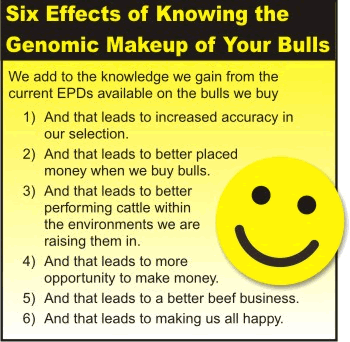
Kris Ringwall
Beef Talk
Genomics lead to a better beef business.
Today's beef cattle are the result of selection processes that have been refined for centuries. Producers have developed a strong genetic base and are designing cattle to meet the production criteria needed to fit their individual environments.
Producers simply do not round up rogue cows and calves, select a calf for harvest and then invite the neighbors over for supper. Selection processes allow producers to get a feel for the genes a bull carries without having to gamble on the bull's outward appearance.
Two selection methods are readily applied today. The first is the use of expected progeny differences (EPDs). The second is the development of the newer technologies that involve analyzing DNA, commonly referred to as genomics.
 EPDs help the beef industry evaluate the genetics of a bull. The outward appearance, commonly referred to as phenotype, of a bull is a product of the bull's genes and how those genes interact with the local environment. Then it certainly is reasonable to make every attempt to get the best estimate of what genes are present in each bull.
EPDs help the beef industry evaluate the genetics of a bull. The outward appearance, commonly referred to as phenotype, of a bull is a product of the bull's genes and how those genes interact with the local environment. Then it certainly is reasonable to make every attempt to get the best estimate of what genes are present in each bull.
For years, the environment tended to get in the way. The nice, shiny, perhaps over-conditioned bull did not always sire shiny, well-grown calves in the fall. Producers experienced a major letdown and realized money was wasted on an overinflated bull. Published EPD values for each bull are intended to help producers avoid buying mistakes. EPDs inform producers of the expected performance of the bull's offspring relative to other bulls in the breed. Producers literally buy this expected performance when purchasing bulls with EPD values needed for their respective breeding programs.
The EPD concept and the ability to improve a herd are based on an understanding of accuracy expressed as a value from 0 to 1. The accuracy is an indication of the amount of data going into the EPD estimate.
Accuracy includes the history of an individual's own performance data. Accuracy also includes performance data available within the pedigree of the bull and then progeny performance, performance of the bull's offspring.
Now comes the good news, or better news, depending on how one wants to express it. Newer EPD estimates now have the capacity to add genomic information based on the analysis of the actual DNA of a bull.
The industry has been buzzing about these new analytic procedures, but a lot of chitchat would imply that the clarity of what a DNA analysis might add to a producer's beef cattle breeding program is unclear.
Producers generally grasp the concept that if a particular gene has been identified as bad and the makeup of the gene is known at the molecular or DNA level, then samples can be submitted and evaluated to see if the gene is present. If it is, the animal can be culled. If not, the bull would not have the trait to pass on.
The same is true for published EPD traits. As mentioned earlier, EPDs are estimates that utilize the data of a bull's DNA.
This DNA, combined with management and environmental effects, is responsible for the phenotypic appearance of a bull. The current excitement stems from newer genomic techniques that more directly link the phenotype of a bull to those long strands of DNA that stay very well hidden within chromosomes. These long strands of DNA ultimately are passed on at conception to create new calves.
No, we are not necessarily creating more traits. Through genomics, we are adding to the knowledge we gain from the current EPDs available on the bulls we buy.
And that leads to increased accuracy in our selection. And that leads to better placed money when we buy bulls. And that leads to better performing cattle within the environments we are raising them in.
And that leads to more opportunity to make money. And that leads to a better beef business. And that leads to making us all happy.
Your comments are always welcome at http://www.beeftalk.com. For more information, contact the North Dakota Beef Cattle Improvement Association (NDBCIA) Office, 1041 State Ave., Dickinson, ND 58601, or go to http://www.CHAPS2000.com on the Internet.
Comment on this article.




